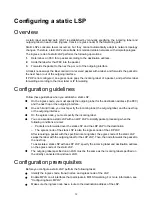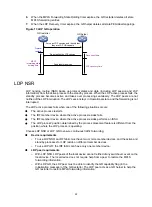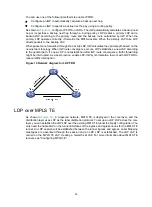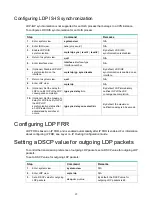
26
Tasks at a glance
(Optional.)
(Optional.)
Enabling SNMP notifications for LDP
Enabling LDP
To enable LDP, you must first enable LDP globally. Then, enable LDP on relevant interfaces or
configure IGP to automatically enable LDP on those interfaces.
Enabling LDP globally
Step Command Remarks
1.
Enter system view.
system-view
N/A
2.
Enable LDP for the local
node or for a VPN.
•
Enable LDP for the local node
and enter LDP view:
mpls ldp
•
Enable LDP for a VPN and enter
LDP-VPN instance view:
a. mpls ldp
b. vpn-instance
vpn-instance-name
By default, LDP is globally
disabled.
3.
Configure an LDP LSR ID.
lsr-id
lsr-id
By default, the LDP LSR ID is
the same as the MPLS LSR ID.
Enabling LDP on an interface
Step Command
Remarks
1.
Enter system view.
system-view
N/A
2.
Enter interface view.
interface
interface-type
interface-number
If the interface is bound to a VPN
instance, you must enable LDP
for the VPN instance by using
the
vpn-instance
command in
LDP view.
3.
Enable IPv4 LDP on the
interface.
mpls ldp enable
By default, IPv4 LDP is disabled
on an interface.
4.
Enable IPv6 LDP on the
interface.
mpls ldp ipv6 enable
By default, IPv6 LDP is disabled
on an interface.
Configuring Hello parameters
Perform this task to set the following hello timers:
•
Link Hello hold time and Link Hello interval.
If an interface is enabled with both IPv4 LDP and IPv6 LDP, the parameters configured on the
interface can be used for both IPv4 and IPv6 Link Hello messages.
•
Targeted Hello hold time and Targeted Hello interval for a peer.
















































